check engine CHEVROLET CORVETTE 1995 4.G Owners Manual
[x] Cancel search | Manufacturer: CHEVROLET, Model Year: 1995, Model line: CORVETTE, Model: CHEVROLET CORVETTE 1995 4.GPages: 386, PDF Size: 20.15 MB
Page 29 of 386
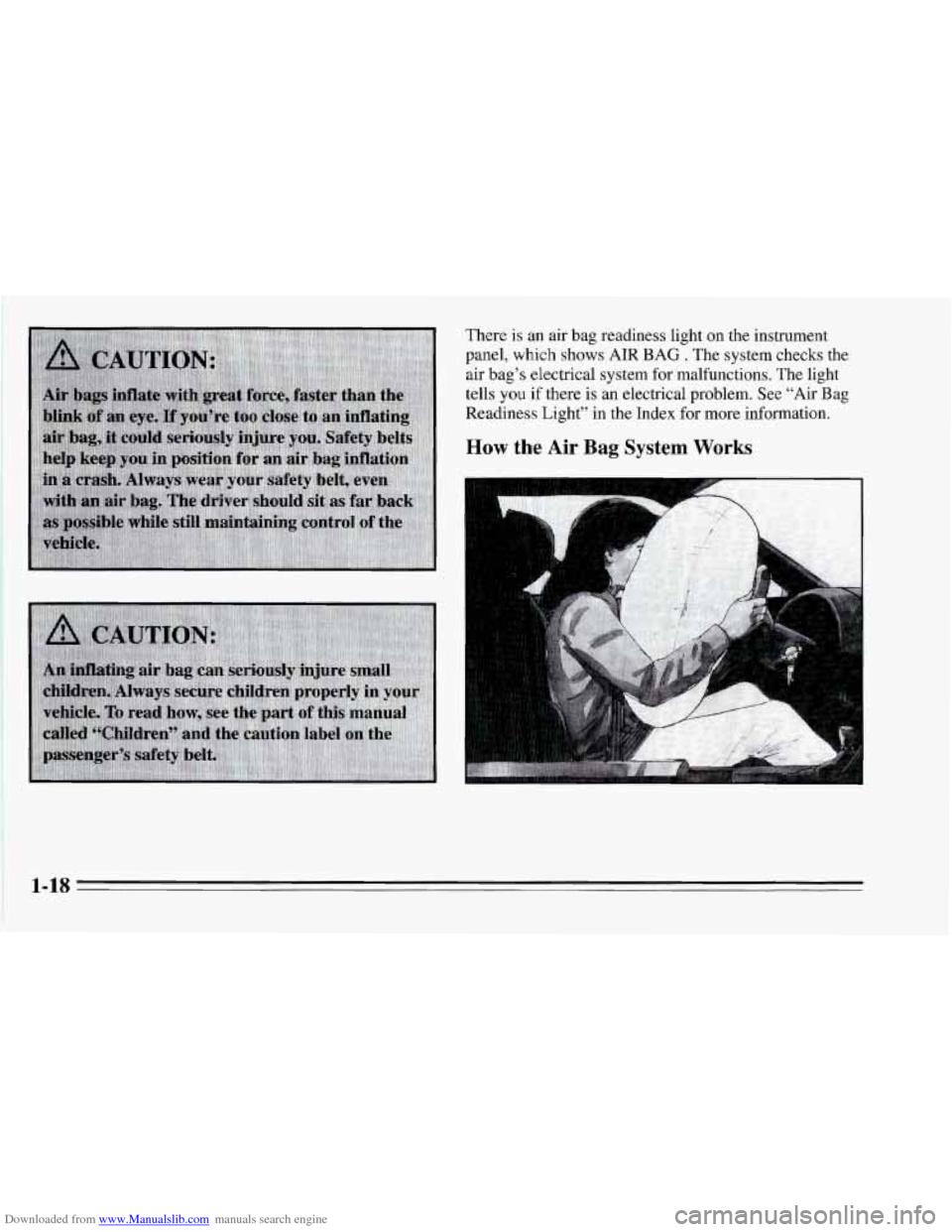
Downloaded from www.Manualslib.com manuals search engine There is an air bag readiness light on the instrument
panel, which shows
AIR BAG . The system checks the
air bag’s electrical system for malfunctions. The light
tells you if there is an electrical problem. See “Air Bag
Readiness Light” in the Index for more information.
How the Air Bag System Works
1-18
Page 41 of 386
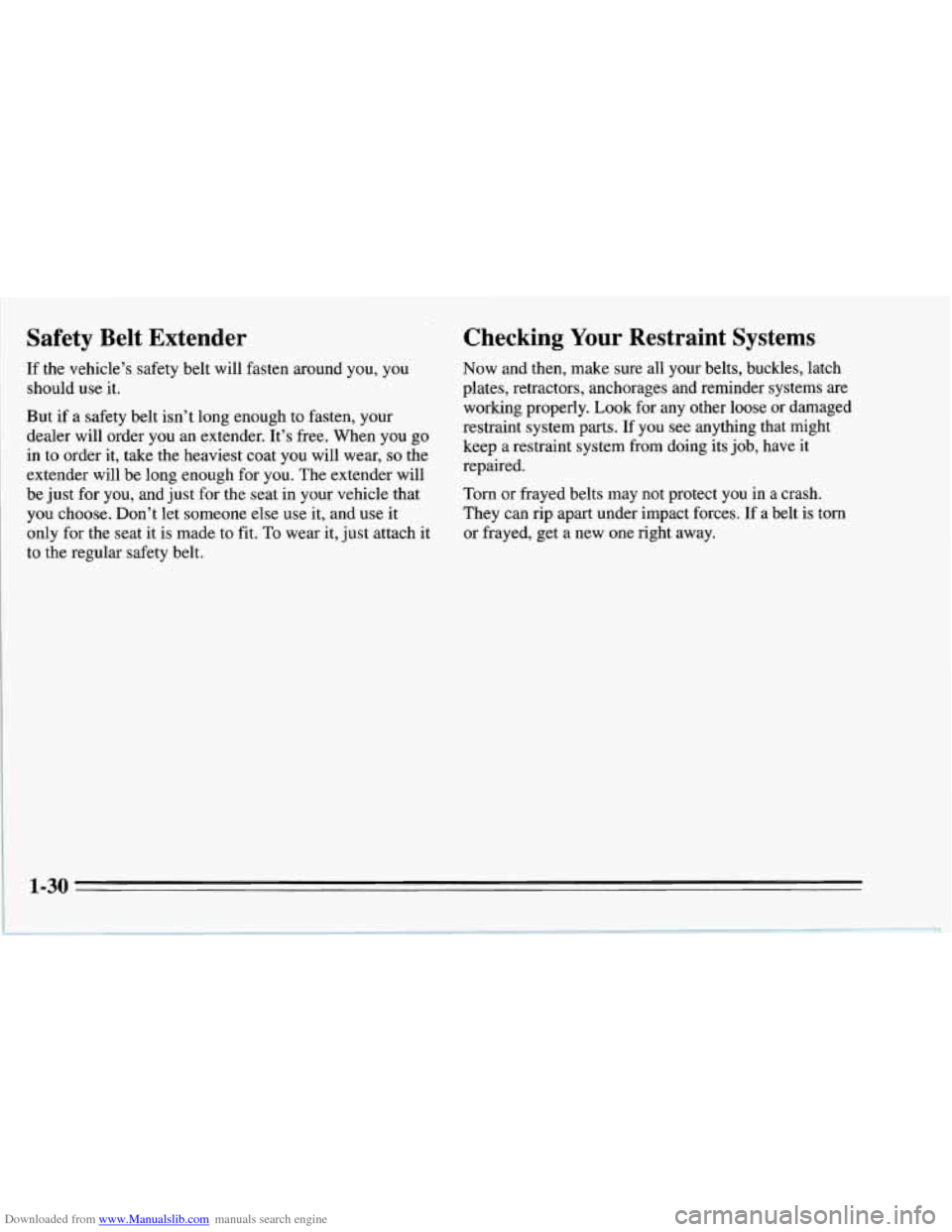
Downloaded from www.Manualslib.com manuals search engine Safety Belt Extender
If the vehicle’s safety belt will fasten around you, you
should use it.
But if a safety belt isn’t long enough to fasten, your
dealer will order you an extender. It’s free. When you go
in to order it, take the heaviest coat you will wear,
so the
extender will be long enough for you. The extender will
be just for you, and just for the seat in your vehicle that
you choose. Don’t let someone else use it, and use it
only
for the seat it is made to fit. To wear it, just attach it
to the regular safety belt.
Checking Your Restraint Systems
Now and then, make sure all your belts, buckles, latch
plates, retractors, anchorages and reminder systems are
working properly.
Look for any other loose or damaged
restraint system parts.
If you see anything that might
keep a restraint system from doing its job, have it
repaired.
Tom or frayed belts may not protect you in a crash.
They can rip apart under impact forces. If a belt is torn
or frayed, get a new one right away.
1-30
Page 48 of 386
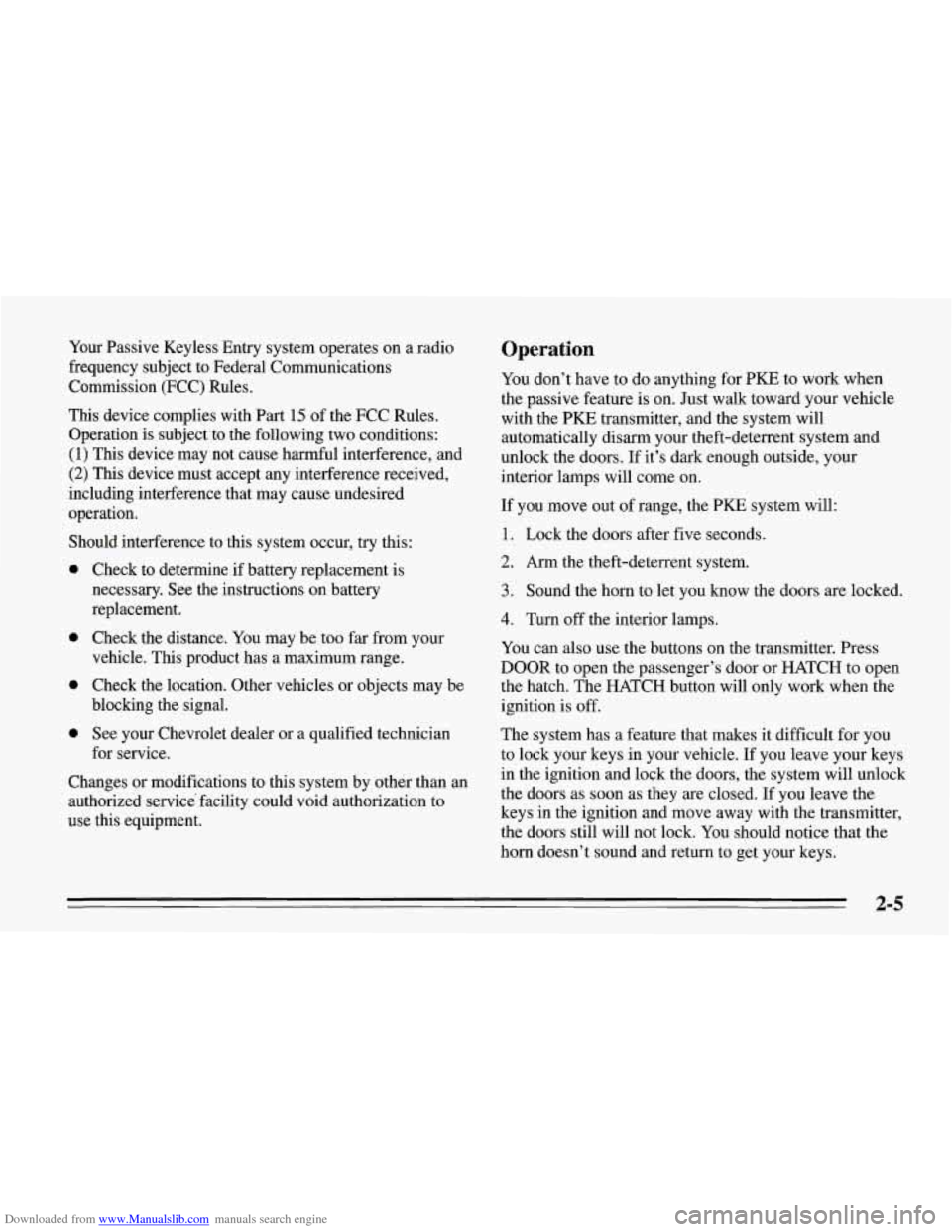
Downloaded from www.Manualslib.com manuals search engine Your Passive Keyless Entry system operates on a radio
frequency subject to Federal Communications
Commission (FCC) Rules.
This device complies with Part
15 of the FCC Rules.
Operation is subject to the following two conditions:
(1) This device may not cause harmful interference, and
(2) This device must accept any interference received,
including interference that may cause undesired
operation.
Should interference to this system occur, try this:
0
0
a
0
Check to determine if battery replacement is
necessary. See the instructions
on battery
replacement.
Check the distance. You may be too far from your
vehicle. This product has a maximum range.
Check the location. Other vehicles or objects may be
blocking the signal.
See your Chevrolet dealer or a qualified technician
for service.
Changes or modifications to this system by other than an
authorized service facility could void authorization to
use this equipment.
Operation
You don’t have to do anything for PKE to work when
the passive feature is on. Just walk toward your vehicle
with the
PKE transmitter, and the system will
automatically disarm your theft-deterrent system and
unlock the doors.
If it’s dark enough outside, your
interior lamps will come on.
If you move out of range, the PKE system will:
1. Lock the doors after five seconds.
2. Arm the theft-deterrent system.
3. Sound the horn to let you know the doors are locked.
4. Turn off the interior lamps.
You can also use the buttons on the transmitter. Press
DOOR to open the passenger’s door or HATCH to open
the hatch. The HATCH button will only work when the
ignition is off.
The system has a feature that makes it difficult for you
to lock your keys in your vehicle. If you leave your keys
in the ignition and lock the doors, the system will unlock
the doors as soon as they are closed. If you leave the
keys in the ignition and move away with the transmitter,
the doors still will not lock. You should notice that the
horn doesn’t sound and return to get your keys.
Page 49 of 386
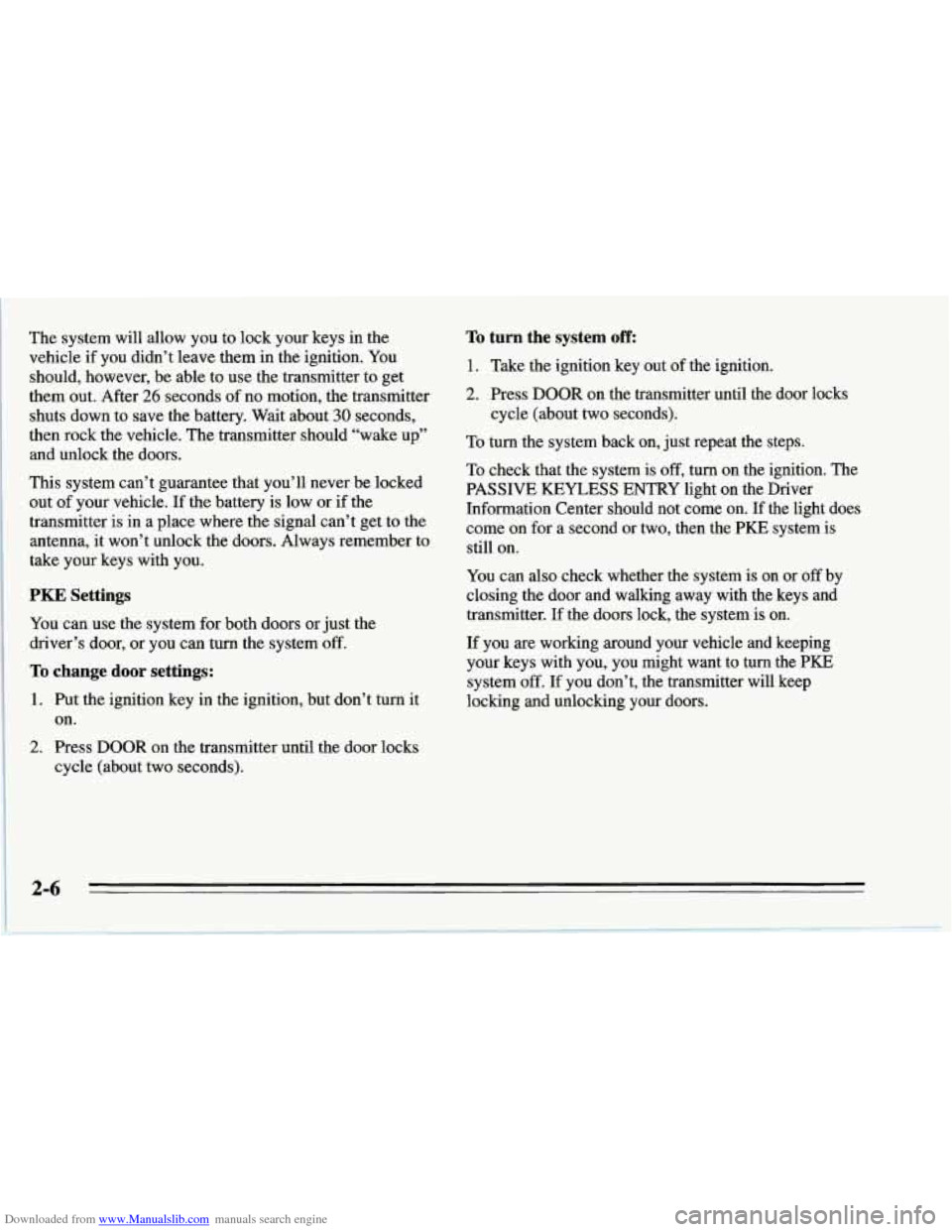
Downloaded from www.Manualslib.com manuals search engine The system will allow you to lock your keys in the
vehicle if you didn’t leave them in the ignition. You
should, however, be able to use the transmitter to get
them out. After
26 seconds of no motion, the transmitter
shuts down to save the battery. Wait about
30 seconds,
then rock the vehicle. The transmitter should “wake
up”
and unlock the doors.
This system can’t guarantee that you’ll never be locked
out of your vehicle. If the battery is low or if the
transmitter is in a place where the signal can’t get to the
antenna, it won’t unlock the doors. Always remember to
take your keys with you.
PKE Settings
You can use the system for both doors or just the
driver’s door, or you can turn the system
off.
To change door settings:
1. Put the ignition key in the ignition, but don’t turn it
2. Press DOOR on the transmitter until the door locks
on.
cycle
(about two seconds).
To turn the system off:
1. Take the ignition key out of the ignition.
2. Press DOOR on the transmitter until the door locks
cycle (about two seconds).
To turn the system back on, just repeat the steps.
To check that the system is
off, turn on the ignition. The
PASSIVE
KEYLESS ENTRY light on the Driver
Information Center should not come on. If the light does
come on for a second or two, then the PKE system is
still on.
You can also check whether the system is on or
off by
closing the door and walking away with the keys and
transmitter. If the doors lock, the system is on.
If you are working around your vehicle and keeping
your keys with you, you might want to
turn the PKE
system
off. If you don’t, the transmitter will keep
locking and unlocking your doors.
2-6
Page 50 of 386
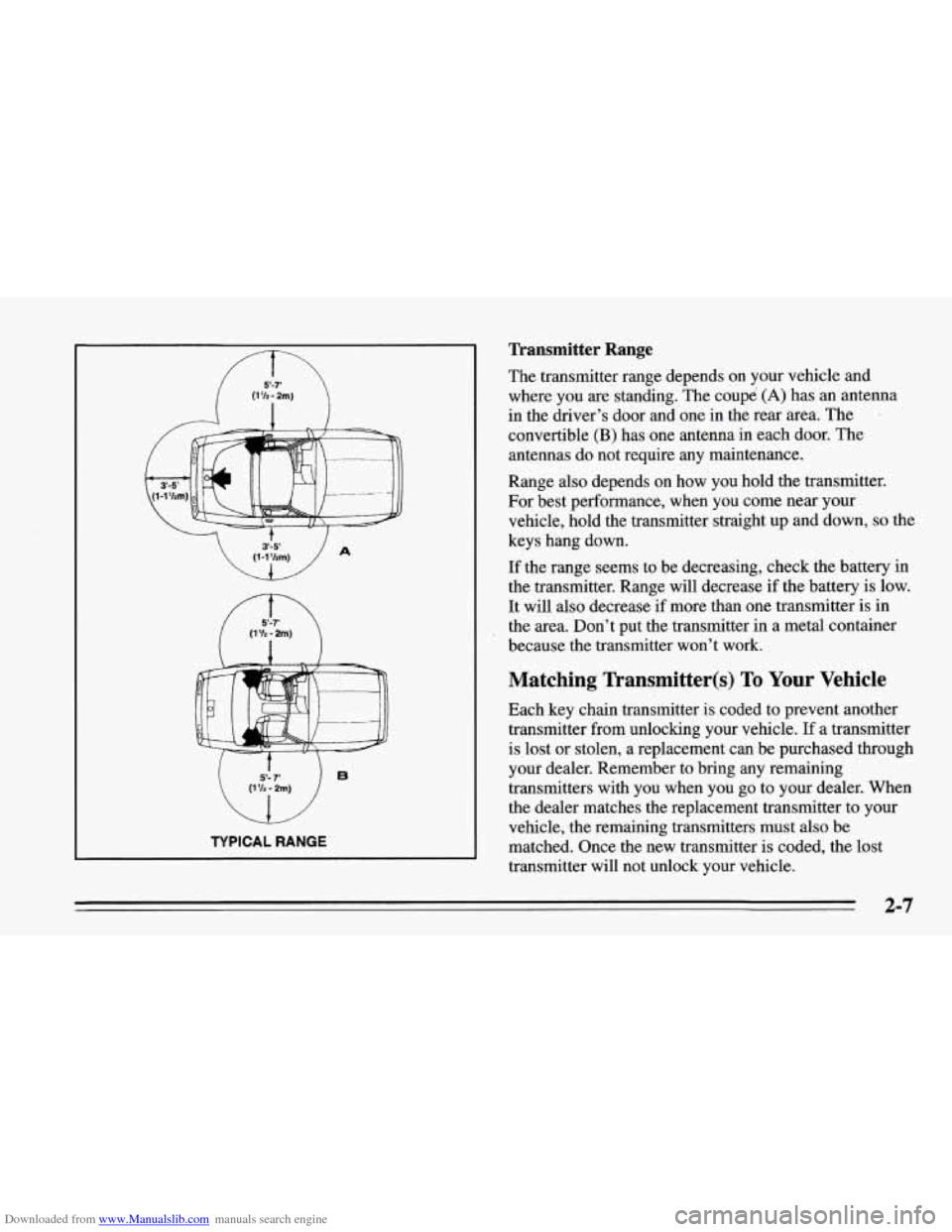
Downloaded from www.Manualslib.com manuals search engine WA
(l-l%m)
(1 VZ - 2m)
5'- 7' (1 '12 - 2m)
TYPICAL RANGE
Transmitter Range
The transmitter range depends on your vehicle and
where you are standing. The coupk
(A) has an antenna
in the driver's door and one
in the rear area. The -
convertible (B) has one antenna in each door. The
antennas
do not require any maintenance.
Range also depends on how you hold the transmitter.
For best performance, when you come near your
vehicle, hold the transmitter straight up and down,
so the
keys hang down.
If the range seems to be decreasing, check the battery in
the transmitter. Range will decrease if the battery is low.
It will also decrease if more than one transmitter
is in
the area. Don't put the transmitter in a metal container
because the transmitter won't work.
Matching Transmitter(s) To Your Vehicle
Each key chain transmitter is coded to prevent another
transmitter from unlocking your vehicle.
If a transmitter
is lost or stolen, a replacement can be purchased through
your dealer. Remember to bring
any remaining
transmitters with you when you go to your dealer. When
the dealer matches the replacement transmitter to your
vehicle, the remaining transmitters must also be
matched. Once the new transmitter is coded, the lost
transmitter will not unlock your vehicle.
2-7
Page 56 of 386
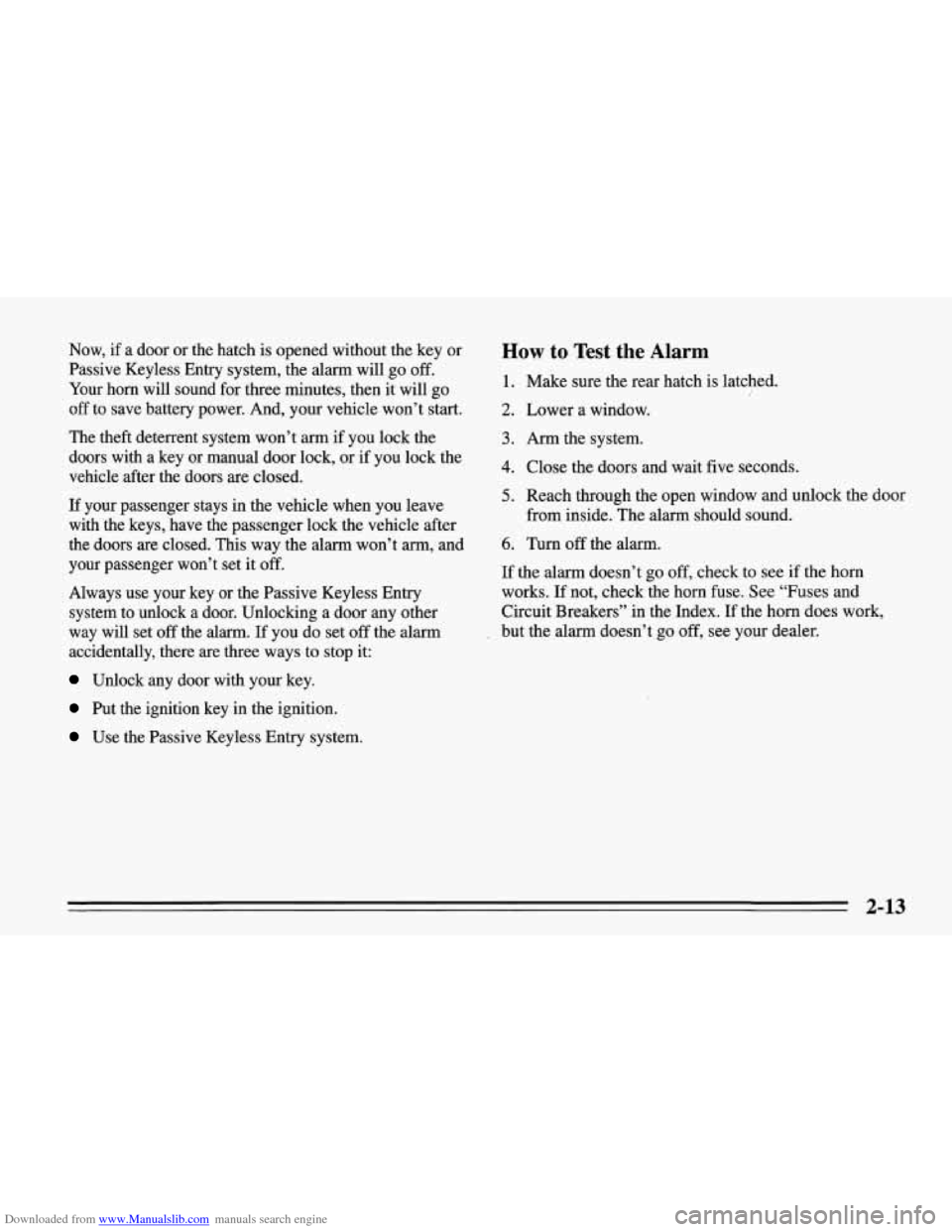
Downloaded from www.Manualslib.com manuals search engine Now, if a door or the hatch is opened without the key or
Passive Keyless Entry system, the alarm will go off.
Your horn will sound for three minutes, then it will go
off to save battery power. And, your vehicle won’t start.
The theft deterrent system won’t arm if you lock the
doors with a key or manual door lock, or if you lock the
vehicle after the doors are closed.
If your passenger stays in the vehicle when you leave
with the keys, have the passenger lock the vehicle after
the doors are closed. This way the alarm won’t
arm, and
your passenger won’t set it
off.
Always use your key or the Passive Keyless Entry
system to unlock a door. Unlocking a door any other
way will set off the alarm. If you do set off the alarm
accidentally, there are three ways to stop it:
Unlock any door with your key.
Put the ignition key in the ignition.
Use the Passive Keyless Entry system.
How to Test the Alarm
1. Make sure the rear hatch is latched.
2. Lower a window.
3. Arm the system.
4. Close the doors and wait five seconds.
5. Reach through the open window and unlock the door
from inside. The alarm should sound.
6. Turn off the alarm.
If the alarm doesn’t go off, check to see if the horn
works. If not, check the horn fuse. See “Fuses and
Circuit Breakers” in the Index. If the
horn does work,
. but the alarm doesn’t go off, see your dealer.
2-13
Page 57 of 386
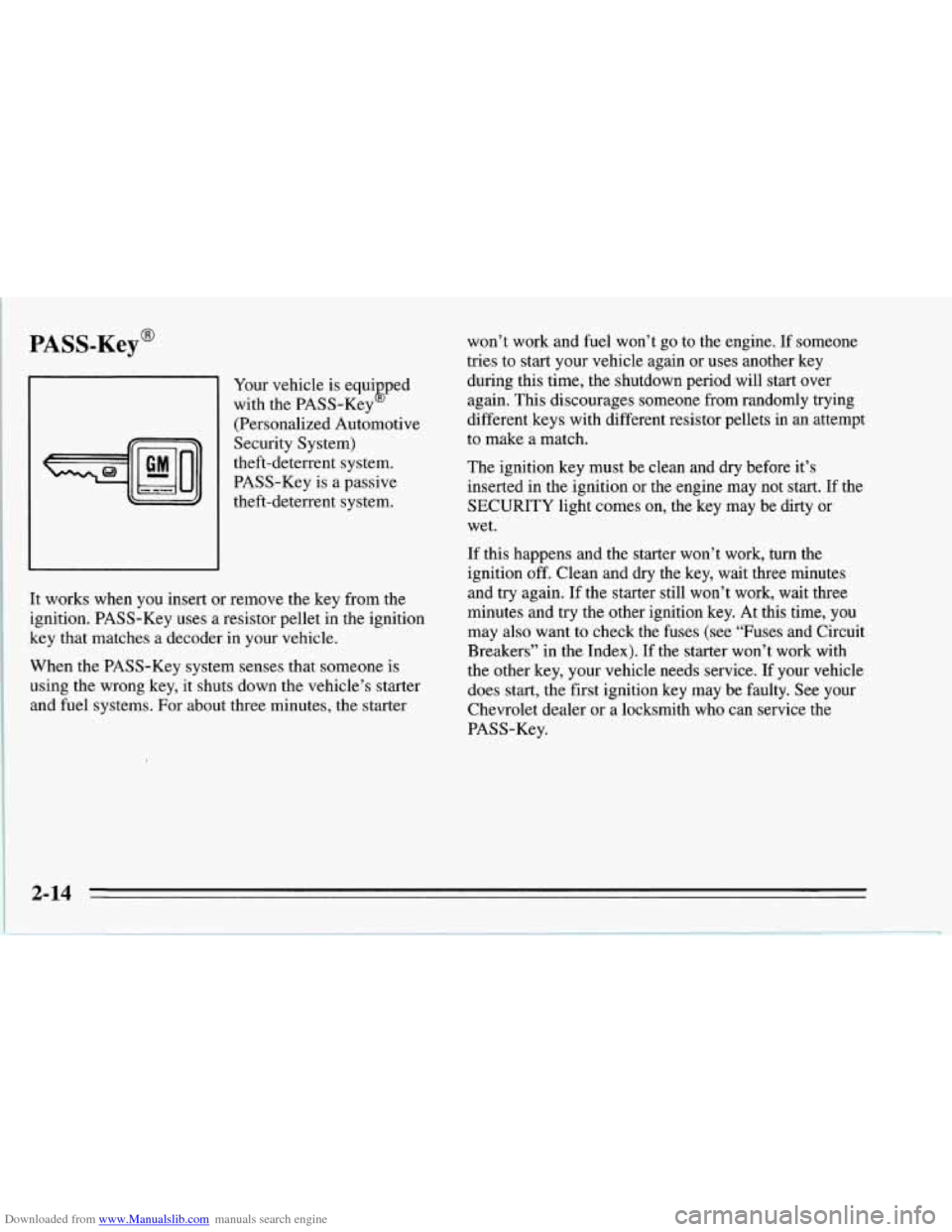
Downloaded from www.Manualslib.com manuals search engine PASS-Key@
Your vehicle is equi ped
with the PASS-Key
(Personalized Automotive
Security System)
theft-deterrent system.
PASS-Key is a passive
theft-deterrent system.
It works when you insert or remove the key from the
ignition. PASS-Key uses a resistor pellet in the ignition
key that matches a decoder in your vehicle.
When the PASS-Key system senses that someone is
using the wrong key, it shuts down the vehicle’s starter
and fuel systems. For about three minutes, the starter won’t work and
fuel won’t go to the engine. If someone
tries to start your vehicle again or uses another key
during this time, the shutdown period will start over
again. This discourages someone from randomly trying
different keys with different resistor pellets in an attempt
to make a match.
The ignition key must be clean and dry before it’s
inserted in the ignition or the engine may not start. If the
SECURITY light comes on, the key may be dirty or
wet.
If this happens and the starter won’t work, turn the
ignition
off. Clean and dry the key, wait three minutes
and
try again. If the starter still won’t work, wait three
minutes and try the other ignition key. At this time, you
may also want to check the fuses (see “Fuses and Circuit
Breakers” in the Index). If the starter won’t work with
the other key, your vehicle needs service.
If your vehicle
does start, the first ignition key may be faulty. See your
Chevrolet dealer or a locksmith who can service the
PASS-Key.
2-14
Page 62 of 386
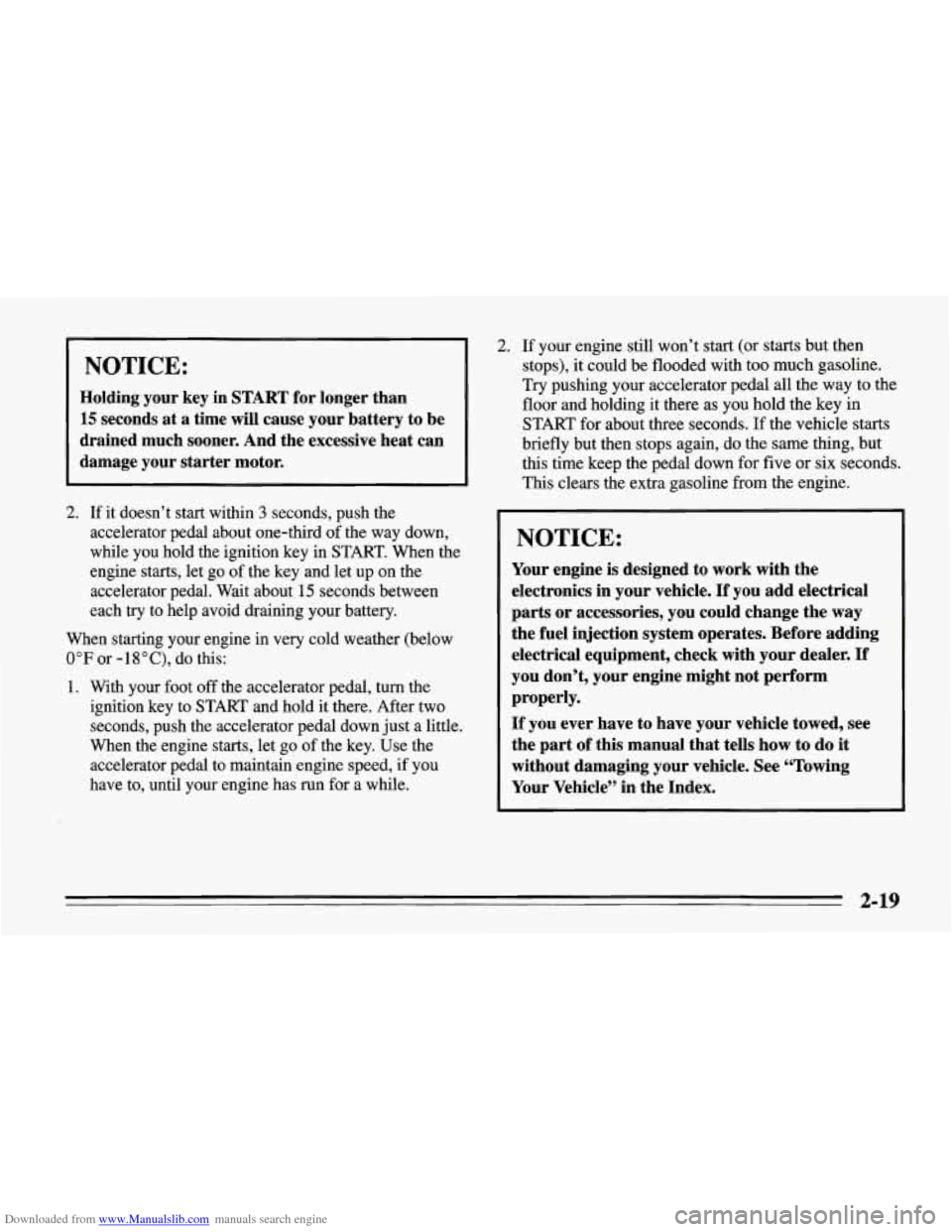
Downloaded from www.Manualslib.com manuals search engine NOTICE:
Holding your key in START for longer than
15 seconds at a time will cause your battery to be
drained much sooner. And the excessive heat can
damage your starter motor.
2. If it doesn’t start within 3 seconds, push the
accelerator pedal about one-third of the way down,
while you hold the ignition key in START. When the
engine starts, let go
of the key and let up on the
accelerator pedal. Wait about
15 seconds between
each try to help avoid draining your battery.
When starting your engine in very cold weather (below
0°F or -18”C), do this:
1. With your foot off the accelerator pedal, turn the
ignition key to START and hold it there. After two
seconds, push the accelerator pedal down just a little.
When the engine starts, let go
of the key. Use the
accelerator pedal to maintain engine speed,
if you
have to, until your engine has run for a while.
2. If your engine still won’t start (or starts but then
stops), it could be flooded with too much gasoline.
Try pushing your accelerator pedal all the way to the
floor and holding it there as you hold the key
in
START for about three seconds. If the vehicle starts
briefly but then stops again, do the same thing, but
this time keep the pedal down for five or six seconds.
This clears the extra gasoline from the engine.
NOTICE:
Your engine is designed to work with the
electronics in your vehicle.
If you add electrical
parts or accessories, you could change the
way
the fuel injection system operates. Before adding
electrical equipment, check with your dealer.
If
you don’t, your engine might not perform
properly.
If you ever have to have your vehicle towed, see
the part of this manual that tells how to do
it
without damaging your vehicle. See “Towing
Your Vehicle” in the Index.
2-19
Page 63 of 386
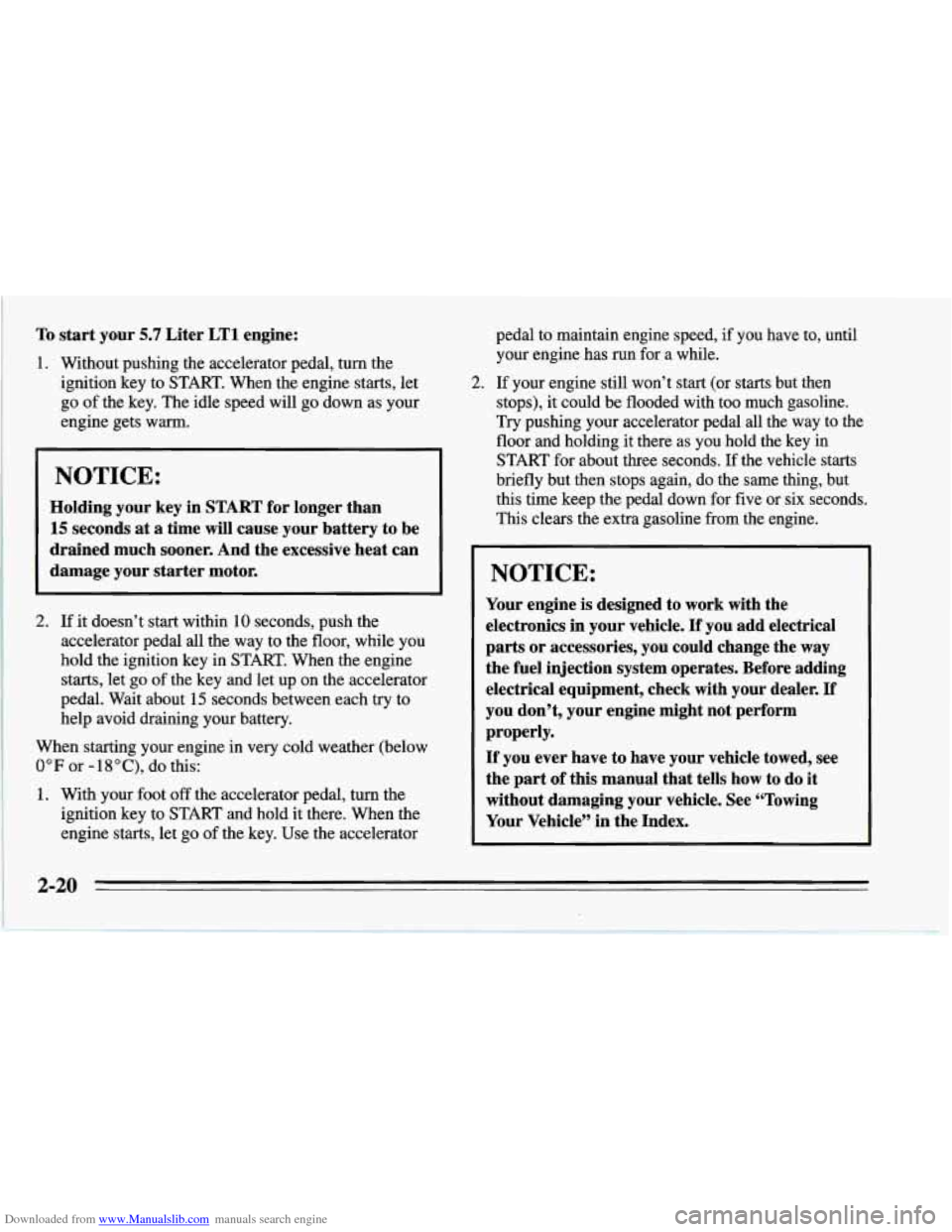
Downloaded from www.Manualslib.com manuals search engine To start your 5.7 Liter LTl engine:
1. Without pushing the accelerator pedal, turn the
ignition key to START. When the engine starts, let
go of the key. The idle speed will go down as your
engine gets warm.
I 1
I NOTICE:
Holding your key in START for longer than
15 seconds at a time will cause your battery to be
drained much sooner. And the excessive heat can
damage your starter motor.
2.
If it doesn’t start within 10 seconds, push the
accelerator pedal all the way to the floor, while you
hold the ignition key in START. When the engine
starts, let go of the key and let up on the accelerator
pedal. Wait about
15 seconds between each try to
help avoid draining your battery.
When starting your engine
in very cold weather (below
0°F or -18”C), do this:
1. With your foot off the accelerator pedal, turn the
ignition key to START and hold it there. When the
engine starts, let go of the key. Use the accelerator pedal
to maintain engine speed, if you have to, until
your engine has run for a while.
stops), it could be flooded with too much gasoline.
Try pushing your accelerator pedal all the
way to the
floor and holding it there as you hold the key in
START for about three seconds. If the vehicle starts
briefly but then stops again, do the same thing, but
this time keep the pedal down for five or six seconds.
This clears the extra gasoline from the engine.
2. If your engine still won’t start (or starts but then
I NOTICE:
Your engine is designed to work with the
electronics in your vehicle.
If you add electrical
parts
or accessories, you could change the way
the fuel injection system operates. Before adding
electrical equipment, check with your dealer.
If
you don’t, your engine might not perform
properly.
If you ever have to have your vehicle towed, see
the part of this manual that tells how to
do it
without damaging your vehicle. See “Towing
Your Vehicle” in the Index.
2-20
Page 65 of 386
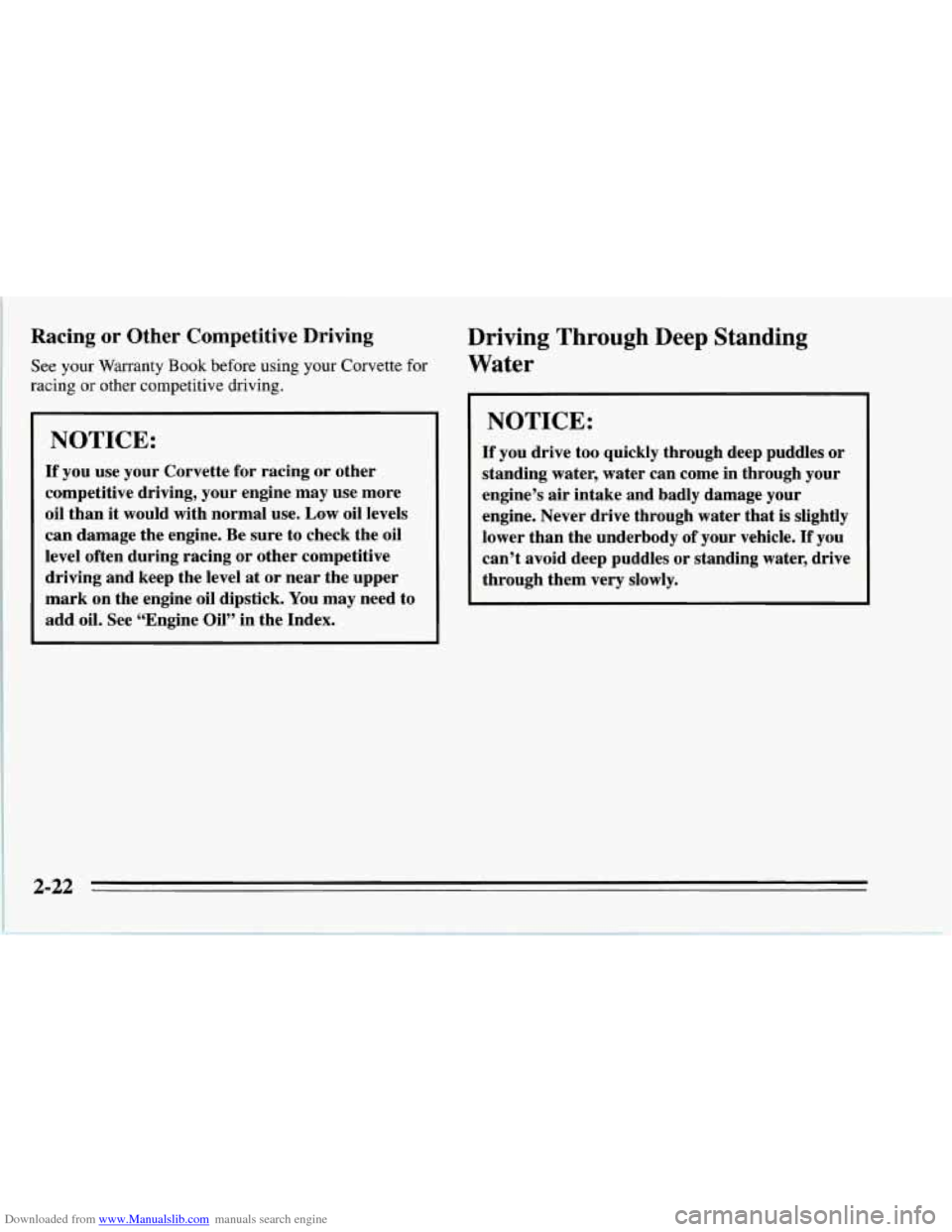
Downloaded from www.Manualslib.com manuals search engine Racing or Other Competitive Driving
See your Warranty Book before using your Corvette for
racing
or other competitive driving.
NOTICE:
If you use your Corvette for racing or other
competitive driving, your engine may use more oil than
it would with normal use. Low oil levels
can damage the engine. Be sure to check the oil
level often during racing or other competitive
driving and keep the level at or near the upper
mark on the engine oil dipstick. You may need to
add oil. See “Engine Oil” in the Index.
J
Driving Through Deep Standing
Water
NOTICE:
If you drive too quickly through deep puddles or
standing water, water can come in through your
engine’s air intake and badly damage your
engine. Never drive through water that is slightly
lower than the underbody of your vehicle.
If you
can’t avoid deep puddles or standing water, drive
through them very slowly.
2-22